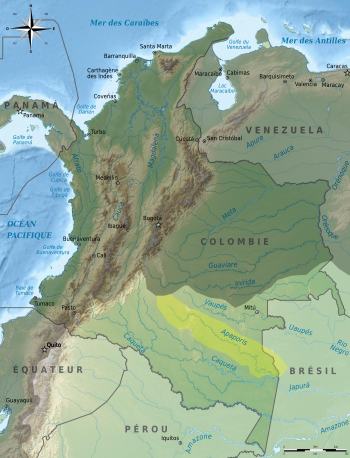Apaporis River facts for kids
Quick facts for kids Apaporis River |
|
|---|---|

Apaporis drainage basin
|
|
| Countries | |
| Physical characteristics | |
| Main source | Confluence of the Ajajú and Tunía River, Caquetá, Colombia |
| River mouth | Japurá River, Amazonas, Brazil 1°22′34″S 69°25′10″W / 1.376147°S 69.419475°W |
| Length | 960 km (600 mi) |
| Basin features | |
| River system | Japurá River |
| Basin size | 53,509 km2 (20,660 sq mi) 57,430.6 km2 (22,174.1 sq mi) |
| Tributaries |
|
The Apaporis River is an important river in South America. It flows mostly through Colombia. For a part of its journey, it also forms a natural border with Brazil. This river is a major branch, or tributary, of the larger Caquetá or Japurá River.
The Apaporis River is about 960 km (600 mi) long. That's like driving from New York City to Atlanta! Its basin, which is the area of land that drains into the river, covers about 53,509 km2 (20,660 sq mi). This huge area is home to many different plants and animals.
Contents
Journey of the Apaporis River
The Apaporis River starts in the Caquetá Department of Colombia. It begins where two smaller rivers, the Ajajú and the Tunía River, meet.
Where the River Flows
As the Apaporis River travels, it flows through the Vaupés Department in Colombia. This region is known for its dense rainforests. Eventually, the river reaches the Japurá River in the Amazonas State of Brazil.
A Natural Border
Near its end, the Apaporis River becomes a natural boundary. It separates Colombia from Brazil for a significant stretch. This makes it an "international river."
Life Around the Apaporis
The areas around the Apaporis River are rich in biodiversity. This means there are many different kinds of plants and animals. The river and its surrounding forests are home to various species. Many indigenous communities also live along the river. They have a deep connection to the land and the water.
See also
 In Spanish: Río Apaporis para niños
In Spanish: Río Apaporis para niños

